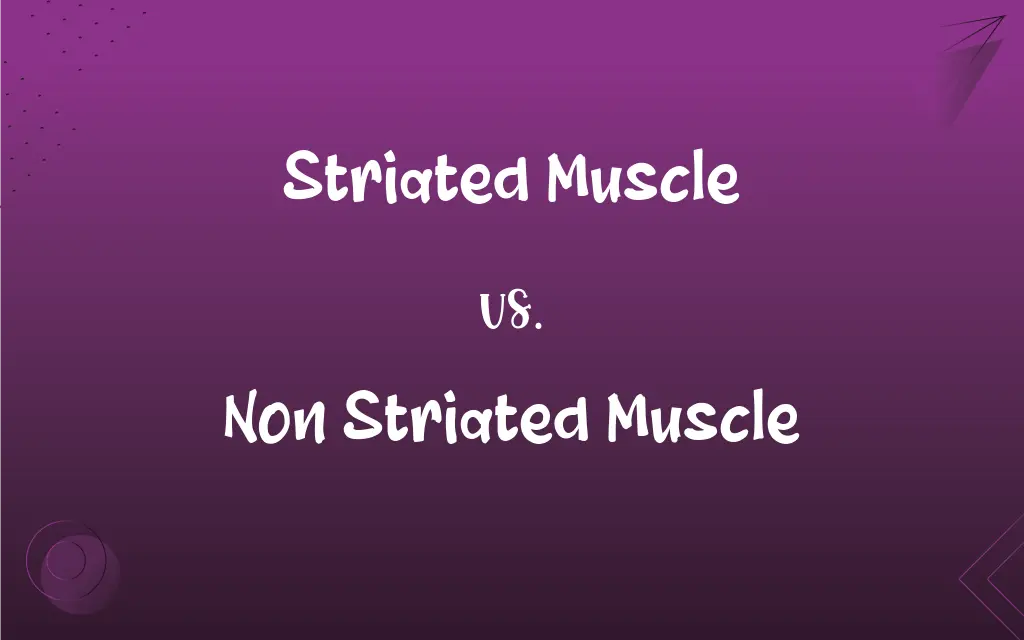Striated Muscle vs. Non Striated Muscle: What's the Difference?
Edited by Janet White || By Harlon Moss || Updated on October 3, 2023
Striated muscle is characterized by visible bands, is usually attached to bones, and is voluntarily controlled, while non-striated muscle is smooth, found in organs, and involuntarily controlled.

Key Differences
Striated muscle, due to its marked bands or striations visible under the microscope, is distinct and notably found in skeletal and cardiac muscle types. Non-striated muscle, in contrast, doesn’t exhibit such visual bands or striations and is essentially smoother in appearance. The fundamental contrast between striated muscle and non-striated muscle extends significantly into their respective locations within the human body and functionalities.
In general physiological terms, striated muscle predominantly adheres to the body's skeletal frame, thereby playing a pivotal role in facilitating intentional, voluntary movements. Conversely, non-striated muscle forms part of the structure of various internal organs (like the digestive tract and blood vessels) and operates involuntarily, executing unconscious, automatic bodily functions. This dichotomy is essential to comprehend as striated muscles empower our deliberate actions, while non-striated muscles silently manage the unperceived internal processes.
Examining the anatomical structure, striated muscle fibers tend to be elongated and cylindrical, enabling a prominent, sturdy structure facilitating forceful, directed motion. In stark disparity, non-striated muscle fibers commonly assume a spindle shape, offering a more diffused and subtle motion, as is necessitated by their role in gently propelling internal contents such as blood or food. Here, striated muscle provides raw power and precision, while non-striated muscle provides a gentler, persistent action.
Focusing on the speed and control of contraction, striated muscle can contract rapidly and with significant force, but for shorter durations due to rapid fatigue. Contrariwise, non-striated muscle contracts with a slower, sustained approach and is resistant to fatigue. This implies that striated muscle is optimized for swift, potent actions, whereas non-striated muscle excels in maintaining prolonged, continual activities without tiring.
Lastly, regarding regulation and control, striated muscle is chiefly regulated by the somatic nervous system, ensuring volitional control. The non-striated muscle is typically overseen by the autonomic nervous system, securing autonomous, self-regulated functioning. This demonstrates that striated muscle is at our conscious beck and call, performing as per our will, while non-striated muscle quietly performs its duties, liberated from our direct influence or control.
ADVERTISEMENT
Comparison Chart
Appearance
Has visible striations or bands.
Smooth, without visible striations.
Location in the Body
Attached to bones or in the heart.
Walls of internal organs & blood vessels.
Control
Voluntary control (conscious).
Involuntary control (unconscious).
Speed of Contraction
Fast and forceful contractions.
Slow and sustained contractions.
Regulation
Regulated by the somatic nervous system.
Regulated by the autonomic nervous system
ADVERTISEMENT
Striated Muscle and Non Striated Muscle Definitions
Striated Muscle
Muscle tissue that exhibits noticeable striations or bands.
The biceps are a type of striated muscle that enables arm movement.
Non Striated Muscle
Smooth muscle lacking visible bands or stripes.
Non-striated muscles in the intestines help move food along.
Striated Muscle
Primarily attached to skeletal structures in the body.
Striated muscles in the legs facilitate walking and jumping.
Non Striated Muscle
Functions involuntarily without conscious control.
The non-striated muscle in our arteries controls blood flow.
Striated Muscle
Predominantly under voluntary, conscious control.
When lifting weights, we consciously engage our striated muscles.
Non Striated Muscle
Primarily located in walls of internal organs and vessels.
Non-striated muscles are integral for digestive processes.
Striated Muscle
Capable of rapid and forceful contractions, but prone to fatigue.
Sprinting heavily utilizes the striated muscles in the legs.
Non Striated Muscle
Known for slow, sustained contractions, and resistance to fatigue.
The bladder, made of non-striated muscle, gradually expands.
Striated Muscle
Regulated by the somatic nervous system.
The intentional movement of fingers involves striated muscles.
Non Striated Muscle
Regulated by the autonomic nervous system.
The pupil’s size is controlled by non-striated muscle.
FAQs
Can striated muscle act involuntarily?
Rarely, as striated muscles, especially skeletal muscles, are generally under voluntary control.
What are the visible striations in striated muscles?
Striations in striated muscles are alternating light and dark bands observed under a microscope.
Why doesn’t non-striated muscle require conscious control?
Non-striated muscle autonomously manages continual internal processes, like digestion and circulation, without requiring conscious intervention.
Where is non-striated muscle typically found in the body?
Non-striated muscle is commonly found in the walls of internal organs, like the digestive tract and blood vessels.
Is non-striated muscle capable of rapid contraction?
No, non-striated muscle typically contracts slowly and is optimized for sustained actions.
What is the primary function of striated muscles in the body?
Striated muscles primarily enable movement of the skeleton and function in the pumping of the heart.
How does non-striated muscle contribute to homeostasis?
Non-striated muscle regulates internal processes like moving food through the digestive system and adjusting blood vessel diameter.
Which muscle type, striated or non-striated, is more resistant to fatigue?
Non-striated muscle is more resistant to fatigue due to its slow and sustained contractions.
Can striated muscle be found in the heart?
Yes, the heart contains a special type of striated muscle known as cardiac muscle.
How does the autonomic nervous system interact with non-striated muscle?
The autonomic nervous system automatically regulates non-striated muscle, managing actions like blood vessel dilation without conscious input.
What nervous system regulates striated muscle?
Striated muscle is typically regulated by the somatic nervous system.
What is the significance of striations in striated muscles?
The striations result from a repeating pattern of units called sarcomeres which are essential for muscle contraction.
What role does non-striated muscle play in digestion?
Non-striated muscle propels food through the digestive tract via a process called peristalsis.
How does non-striated muscle assist in regulating blood pressure?
Non-striated muscle in blood vessel walls can adjust vessel diameter, influencing blood pressure and flow.
What provides the energy for striated muscle contraction?
Striated muscle contractions are fueled by ATP produced primarily through cellular respiration.
Can diseases affect non-striated muscle functionality?
Yes, diseases like achalasia can impact non-striated muscle function, specifically impacting peristalsis in the esophagus.
Are striated muscles capable of continuous contraction?
Striated muscles tend to fatigue and are not optimized for sustained, continuous contraction.
Are striated muscles essential for posture?
Yes, striated muscles, particularly skeletal muscles, play a vital role in maintaining posture and stability.
Is non-striated muscle involved in conscious movement?
No, non-striated muscle works involuntarily and is not used for conscious movement.
Is skeletal muscle a type of striated muscle?
Yes, skeletal muscle is a subtype of striated muscle.
About Author
Written by
Harlon MossHarlon is a seasoned quality moderator and accomplished content writer for Difference Wiki. An alumnus of the prestigious University of California, he earned his degree in Computer Science. Leveraging his academic background, Harlon brings a meticulous and informed perspective to his work, ensuring content accuracy and excellence.
Edited by
Janet WhiteJanet White has been an esteemed writer and blogger for Difference Wiki. Holding a Master's degree in Science and Medical Journalism from the prestigious Boston University, she has consistently demonstrated her expertise and passion for her field. When she's not immersed in her work, Janet relishes her time exercising, delving into a good book, and cherishing moments with friends and family.































































